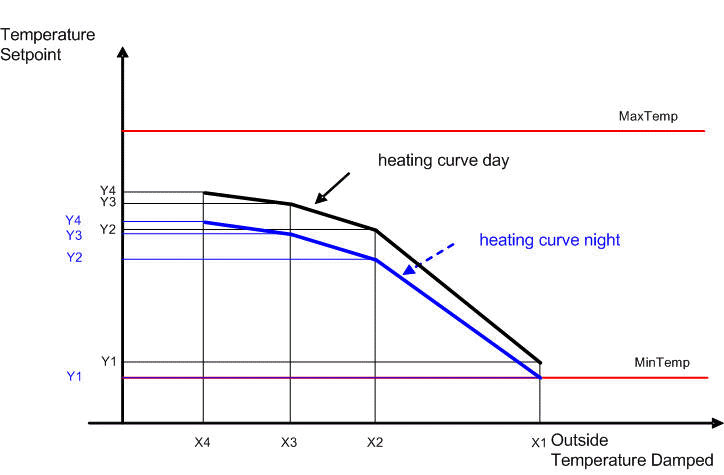FB_HVACHeatingCurve

Application
The four-point heating curve serves to determine the setpoint for the flow temperature of a heating circuit, depending on the outside temperature.
For functional reasons, this function block must be used together with FB_HVACSetpointHeating. The reason for this is that the value for the night setback is taken into account in FB_HVACHeatingCurve.
VAR_INPUT
eDataSecurityType : E_HVACDataSecurityType;
bSetDefault : BOOL;
rOutsideTempDamped: REAL;
bDayOperation : BOOL;
bReset : BOOL; eDataSecurityType:if eDataSecurityType:= eHVACDataSecurityType_Persistent, the persistent VAR_IN_OUT variables of the function block are stored in the flash of the computer if a value changes. For this to work, the function block FB_HVACPersistentDataHandling must be instanced once in the main program, which is called cyclically. Otherwise the instanced FB is not released internally.
A change of value can be initiated by the building management system, a local operating device or via a write access from TwinCAT. When the computer is restarted, the saved data are automatically read back from the flash into the RAM.
Application example:  Example_PERSISTENT.zip
Example_PERSISTENT.zip
If eDataSecurityType:= eHVACDataSecurityType_Idle the persistently declared variables are not saved in a fail-safe manner.
Notice | |
A cyclically changing variable must never be linked with the IN_OUT variable of a function block, if eDataSecurityType:= eHVACDataSecurityType_Persistent. It would lead to early wear of the flash memory. |
bSetDefault: If the variable is TRUE, the default values of the VAR_IN_OUT variables are adopted.
rOutsideTempDamped: this input variable transfers the current damped outside temperature to the function block.
bDayOperation: TRUE = day operation, FALSE = night operation.
bReset: acknowledge input in the event of a fault.
VAR_OUTPUT
rTempSetpoint : REAL; 0 .. 500 ° C
bInvalidParameter: BOOL;rTempSetpoint: the calculated setpoint for the flow temperature.
bInvalidParameter: Indicates that an incorrect input parameter is present. bInvalidParameter must be acknowledged with bReset.
VAR_IN_OUT
rMinTemp : REAL;
rMaxTemp : REAL;
rNightSetback : REAL;
rTempSetpoint_Y1 : REAL;
rTempSetpoint_Y2 : REAL;
rTempSetpoint_Y3 : REAL;
rTempSetpoint_Y4 : REAL;
rOutsideTemp_X1 : REAL;
rOutsideTemp_X2 : REAL;
rOutsideTemp_X3 : REAL;
rOutsideTemp_X4 : REAL; rMinTemp: the minimum value for the setpoint of the flow temperature is defined by this variable. The variable is saved persistently. Preset to 0.
rMaxTemp: the maximum value for the setpoint of the flow temperature is defined by this variable. The variable is saved persistently. Preset to 500.
rNightSetback: the value for the night setback is specified by this variable. The variable is saved persistently. Preset to 20.
rTempSetpoint_Y1 / rOutsideTemp_X1: the course of point 1 of the heating curve is parameterized by this value pair. The variable is saved persistently. Preset to 20.
rTempSetpoint_Y2 / rOutsideTemp_X2: the course of point 2 of the heating curve is parameterized by this value pair. The variable is saved persistently. Preset to 65 and 0.
rTempSetpoint_Y3 / rOutsideTemp_X3: the course of point 3 of the heating curve is parameterized by this value pair. The variable is saved persistently. Preset to 74 and -10.
rTempSetpoint_Y4 / rOutsideTemp_X4: the course of point 4 of the heating curve is parameterized by this value pair. The variable is saved persistently. Preset to 80 and -20.
Course of the heating characteristic curves

Conditions
The following applies to the input of the values:°X1 > X 2 > X3 > X4 and Y1 < Y2 < Y3 < Y4.
Furthermore the minimum value for the setpoint of the flow temperature must be <= rTempSetpoint_Y1 and >= 0. The maximum value for the setpoint of the flow temperature must be >= rTempSetpoint_Y4.
If one of these conditions is not met, the variable bInvalidParameter will be set to TRUE and the default values of the VAR_IN_OUT variables will be adopted.